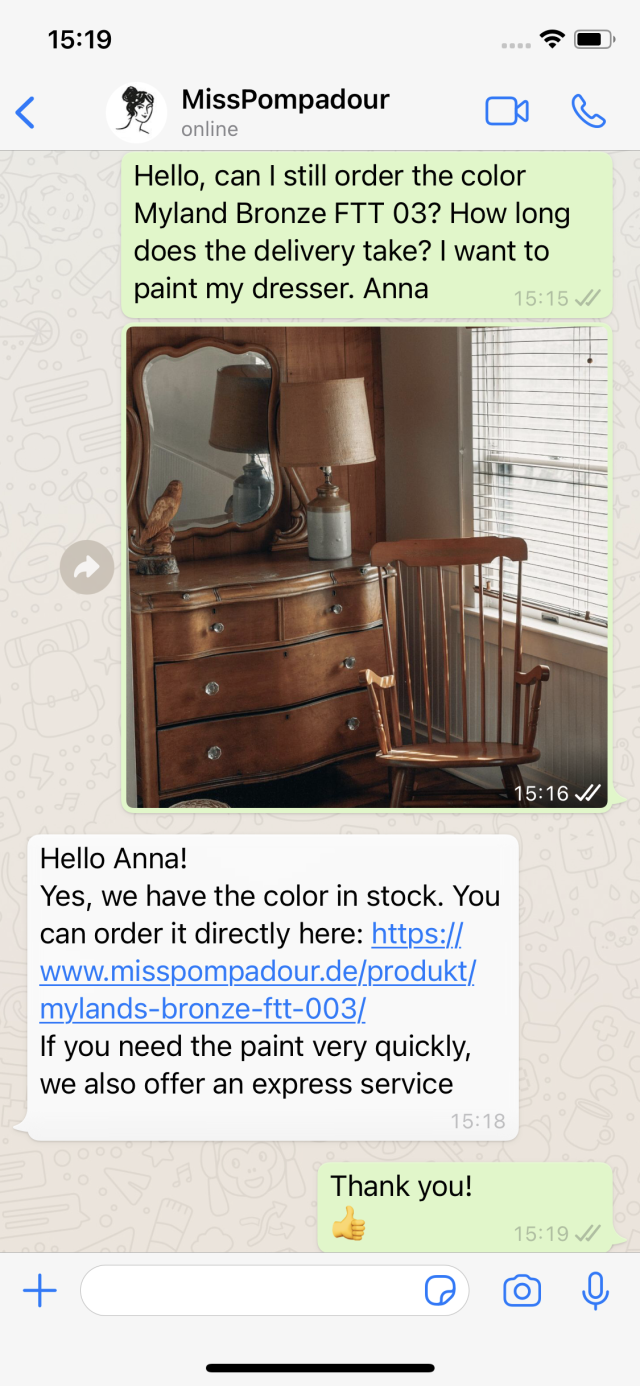Can you use messaging apps in every stage of the customer journey? Absolutely, and even more successfully than other channels! From consultations on Facebook Messenger to marketing messages on WhatsApp to customer service on Telegram: we show you examples of how to use messaging apps along the entire customer journey.
The most successful companies are the ones that understand their customers, and offer them what they need at the right time. That's why it's so important to understand the customer's process for buying something: the customer journey.
Messaging apps are the perfect tool to support customers during this process.
What is the customer journey, and what role do messaging apps play?
The customer journey, also called user journey, is a marketing and sales term. It defines the different steps customers take before they decide to make a purchase. It's important to keep in mind, though, that the customer journey doesn't end with a purchase, but also includes post-sale customer service and future purchases.
What is the customer journey?
Typically, the customer journey can be divided into the following stages:
- Decision stage: "I want to / have to buy something."
- Inspiration stage: "I research and gather inspiration before I buy something."
- Purchase stage: "I choose a provider / product."
- Usage stage: "I use a product and have questions or need help."
- New purchase: "I buy the same product again or choose a different product."
The customer journey is not always linear, though. Customers might leave the purchase stage and go back to the inspiration stage to gather more information on alternatives. The process can also be very long (when buying a new house) or very short (when running into the store to buy milk).
Nevertheless, companies can use this model to develop sales and marketing strategies along the customer journey. If, for example, customers are in the inspiration stage, you should really try to inspire them, and not force them to buy something.
These points of interaction between customers and companies during the customer journey are called touchpoints. These touchpoints always have to offer customers exactly what they need to ensure the best experience.
And that's where messenger apps come in!
What role do messaging apps play througout the customer journey?
The approach of considering the customer journey as an interaction or conversation between customer and company is called conversational commerce. It means that businesses accompany consumers on their customer journey by inviting them to reach out to the company. The customer journey thus becomes a dialogue between users and businesses.
In other words, conversational commerce happens at the intersection between shopping and talking. This is a radical turn from the typical push marketing of "buy this" and "get this product". Instead of pushing for a sale, companies invite customers to talk to them. This allows companies to support customers through the customer journey, and offers a much better user experience.
There are several advantages to this approach.
- Companies get a better idea about what their customers want, and can offer them a more personalized experience.
- At the same time, companies get more valuable information directly from their customers. This allows them to improve their offer.
- Through the personal one-on-one conversation, companies can build more trust and increase customer loyalty.
As channels that are specifically designed for two-way-conversations, messaging apps have a unique vantage point when it comes to reaching consumers during their customer journey.
Messaging unites the best of two worlds for our customers. Messaging apps combine the possibility of personal consultation with the speed, comfort, and flexibility of digital communication.
Matthias Gehring, Chief Digital Officer at TUI
Messaging apps along the customer journey
From the first inspiration from a messaging newsletter to a repeat purchase after chatting with customer service: messenger apps such as WhatsApp, Apple Messages for Business, and Facebook Messenger are the perfect companions for consumers on their customer journey.
And that's not only because messaging apps are designed for conversations, it's also because people love them! Messaging is fast, convenient (you can take the conversation on the go with you), and multimedia features like emojis, videos and voice messages make it more fun to chat. Increasingly, people also use messaging apps to contact businesses.
In the family of Meta messaging apps alone, every week, more than one billion people contact a business on a messaging app.
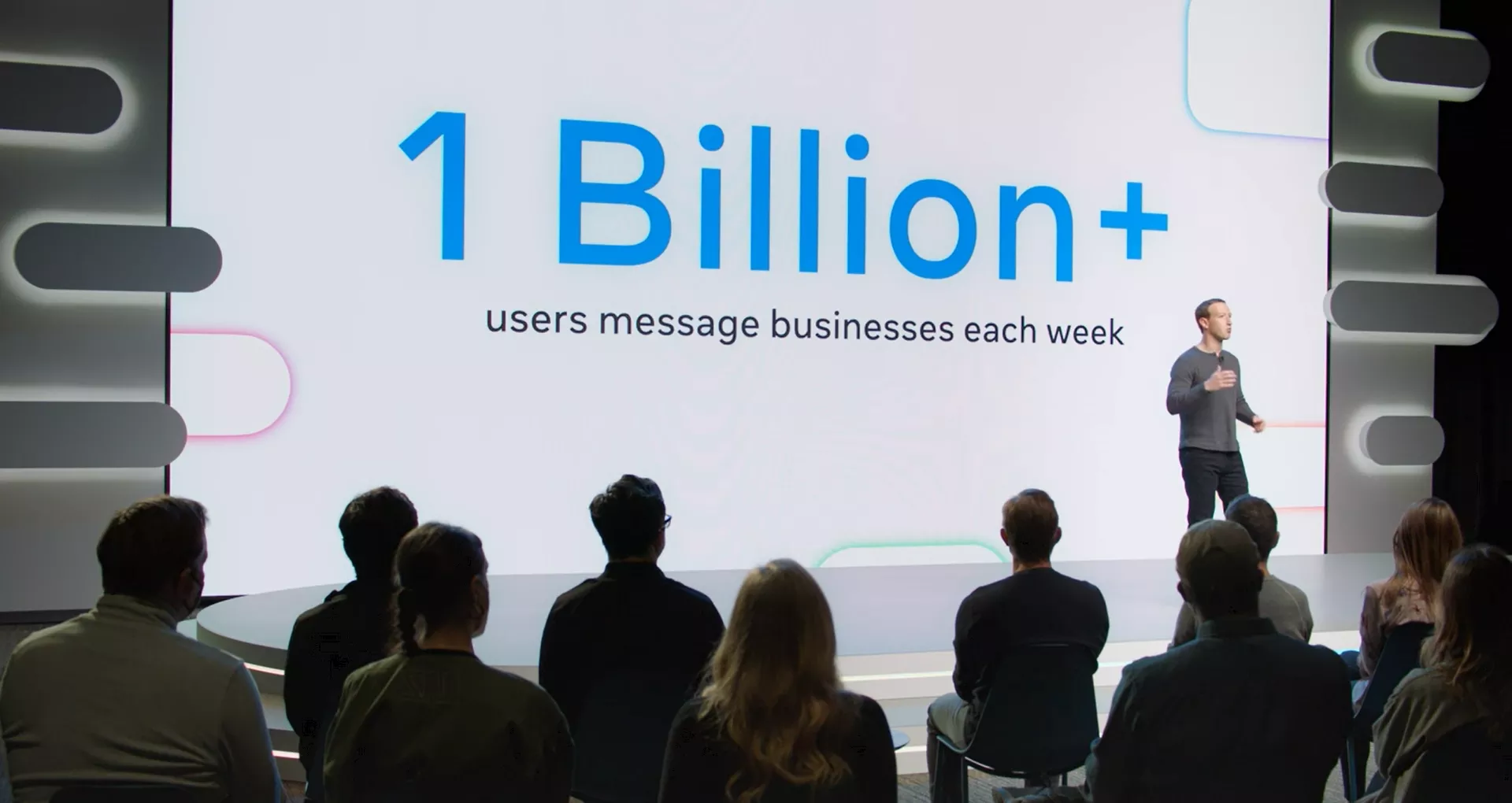
We can see this trend around the world. Brazilians and Mexicans do virtually everything on WhatsApp. In Spain, Telegram is up and coming, and in South Korea nothing works without KakaoTalk. And with 487.5 million users, Indians basically live on WhatsApp, the country's favorite messaging app. Indians use WhatsApp to chat with their loved ones, but also to shop, book an Uber, and even to verify their government ID.
As a business, it only makes sense to meet your customers in the channels they already use and love. And the best part is: messaging is a great tool to improve the experience for every single stage of the customer journey!

1. Marketing
Generating leads via chatbot, introducing a new product, sending out newsletters, content marketing, employer branding, or brand awareness: messenger apps are the perfect marketing tool. Especially the option to engage users via marketing messages (newsletters), is really exciting.
You can send out marketing notifications with:
Compared to e-mail campaigns, messaging newsletters have several advantages: they are fast, end up on the users' locked screens, they don't compete with algorithms, deliver open rates of 90 percent (!), and convert more!

Marketing messages: proactively reaching out to customers
Marketing newsletters, also known as bulk messages or messaging broadcasts, are ideal for reaching out to customers in the consideration phase to send them relevant information. This could be daily updates, a special deal, or shopping inspiration.
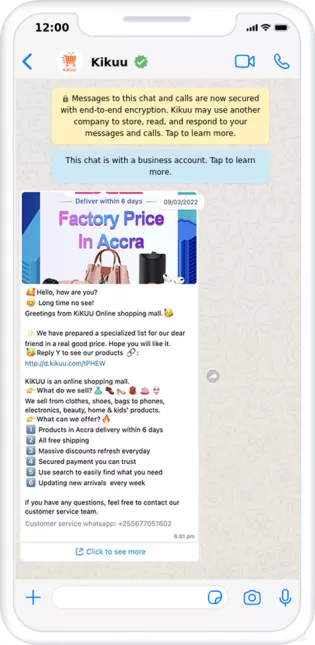
When sending out messaging newsletters, make sure to establish first what type of content your customers are really interested in. After all, you don't want to annoy or spam users. How can you find out what users want to read? Ask them!
That's what the Indian news publication Newschecker does. Before users subscribe to receive regular notifications, they can choose what type of content they are most interested in. That's a great way to both, send users what they want and gather valuable customer data.
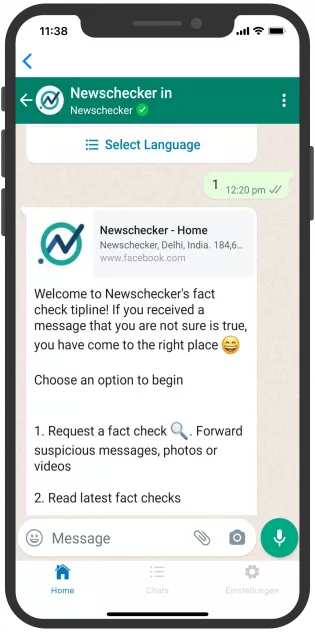
👉 Tool tip: check out "Campaigns", a tool that helps you plan and track your messaging newsletter campaigns.
Pull communication: dialogue as a marketing tool
As mentioned, brands have recognized the advantages of conversational strategies, and increasingly use the approach along the customer journey. In marketing, this could be a fun activity that lets users participate or even a quiz.
The fashion brand Dior, for example, recently launched a conversational campaign to promote a new lipstick. Together with influencer Jisoo, they invited users to chat with Jisoo on WhatsApp to get to know her work as a brand ambassador, and to find out more about Dior's new lipstick. The campaign showed very high user engagement.
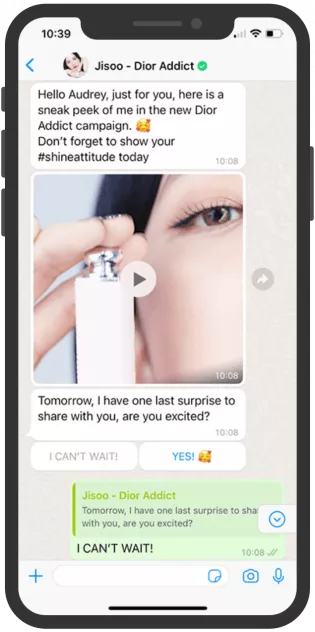
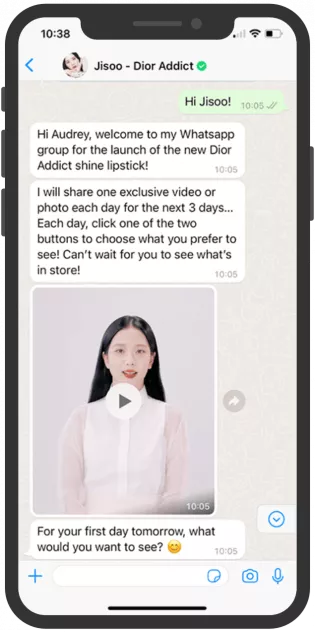
💡 Reading tip: Conversational Marketing: 16 Examples of Successful Brands
2. Consultation
As a dialogue-based form of customer communication, conversational commerce also becomes an important strategy to support customers before they buy something.
Traditionally, customers would get an in-person consultation at a store. With more customers moving to online shopping channels, such as websites or apps, shopping might have gotten easier, but the consultation aspect got lost.
That's where conversational commerce can bring both aspects back together and unite the quick and smooth process of online shopping with the personal consultation via messaging apps.
MissPompadour "WhatsApp is a sales tool for us!"
The e-commerce paint seller, MissPompadour, focuses on selling their customers the best painting option for their needs. This requires thorough and personalized help. What is the best color for my curtains? Should I mix these two colors together to fit my bedroom?
MissPompadour offers their customers the personalized help they need on WhatsApp. Here, customers can video chat, send images of the spaces or objects they want to paint, and receive fast responses.
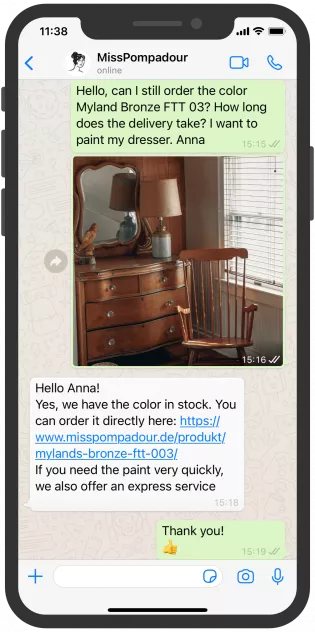
Naturally, this type of customer service almost always leads to a sale, says Erik Reintjes, CEO at MissPompadour.
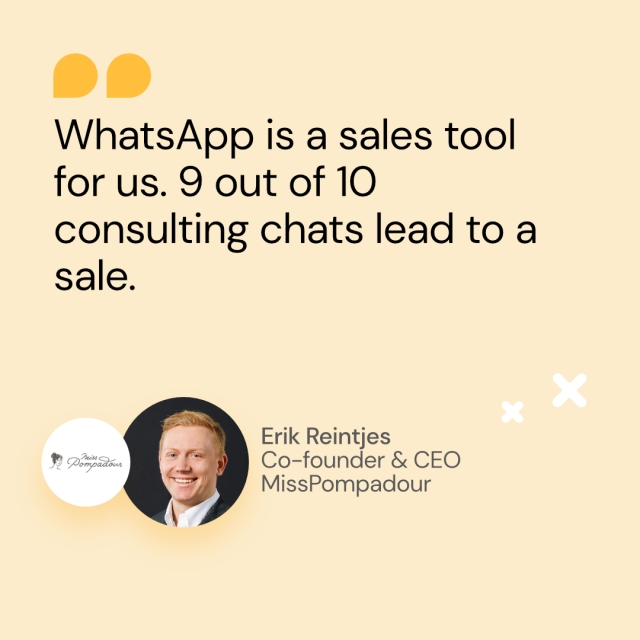
3. Ordering and paying via messaging
As the example of MissPompadour shows, the consideration phase and the purchase phase go hand in hand in conversational commerce. Ideally, customers should be able to complete the whole customer journey in messaging apps, including the final payment. This reduces the risk of losing customers along the way, says Matt Ramerman, President Sinch for Marketing.
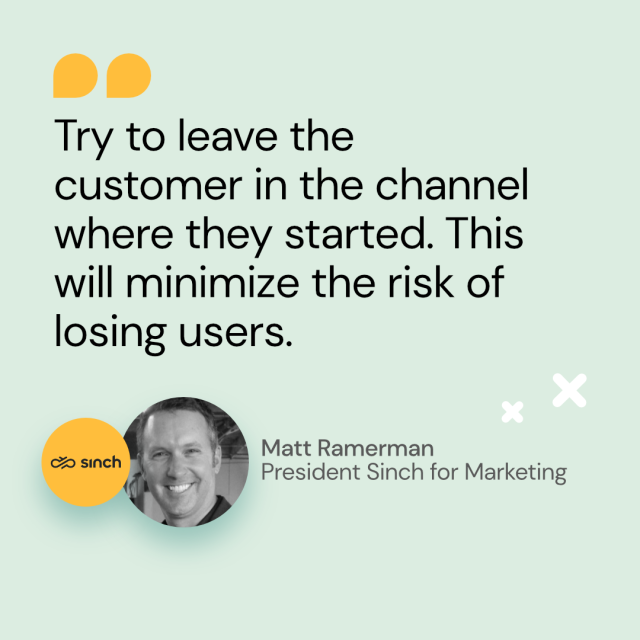
Some messaging apps have already started supporting in-app orders and payments. WhatsApp just launched its first end-to-end shopping experience in India. Instagram Direct now offers an in-chat payment option, and Meta Pay also allows direct payments on Facebook Messenger. KakaoTalk, the Signal Messenger, Telegram, and Viber also offer payment possibilities.
Admittedly, these are still very new options. However, Meta is expanding the payment features gradually to more apps and markets. Apple Messages for Business, on the other hand, shows with their Apple Pay system, how smoothly messaging and payment can go together.
Ultimately, being able to complete the entire customer journey on a messaging app will improve the customer experience, and increase conversions.
We expect a massive growth in revenue from integrating Apple Pay.
David Kurzmann, CEO and co-founder of Women’s Best
Women's Best is an online sports brand that sells their products successfully via web shop, social media and messaging apps. For instance, once a customer completes a purchase in their web shop, customers have the option to leave their WhatsApp or Apple number to receive order confirmation and status updates about their shipment. Of course, customers can also use the same channel to ask Women's Best's customer team questions.
4. Delivery
Having a positive delivery experience is an important part of the customer journey. It's in this post-sale phase that customers develop trust and loyalty, and make the decision to buy again. Messaging apps in this stage of the customer journey allow companies to improve the delivery experience.
Messenger apps like WhatsApp or Facebook Messenger allow you to send out push notifications to customers to inform them about their current delivery or status of a reservation or service.
How does e-commerce company Erwin Müller manage 10,000 delivery status requests on WhatsApp?
Erwin Müller started out as a traditional mail-order business more than 70 years ago, and has become an award-winning online store. The key to their success is to be able to modernize and adapt to new markets.
For instance, the store decided to introduce WhatsApp notifications to reach a young customer base. Now, customers of all ages use WhatsApp to track their orders. With the help of a WhatsApp chatbot, the company has been able to help customers faster, and reduce costs.
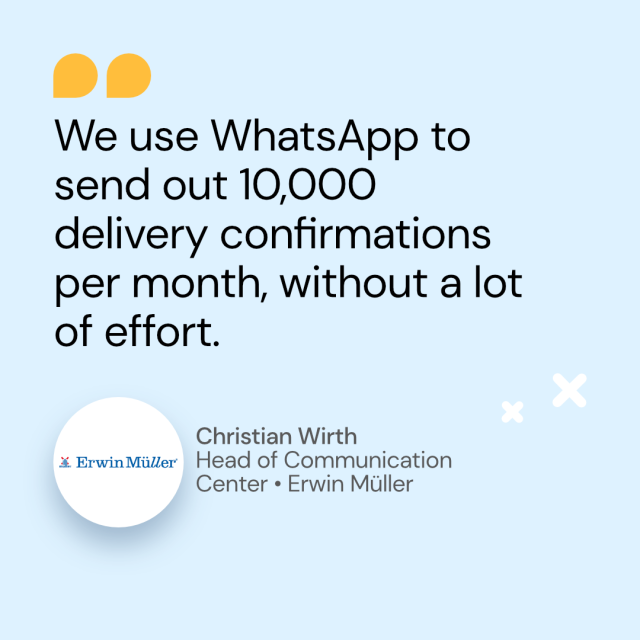
5. Customer service via messaging
While many of the aforementioned messaging touchpoints in the customer journey might still sound novel to a lot of companies, messenger apps are already well-established for customer service.
From Twitter to Instagram Direct Messaging: checking in with brands to ask for fast help has become the norm. For customers, it makes reaching out to a company easier. And for companies, especially with the help of chatbots, they can automate their service, and provide better help while saving money at the same time.
The hair removal company European Wax Center, for example, used Instagram Direct Messaging and Facebook Messenger to update their customers about appointment changes during the Covid-19 lockdowns. With a centralized messaging solution that organized all messages on one platform, reaching out to a large number of customers was easy and smooth, and provided timely information for their clients.
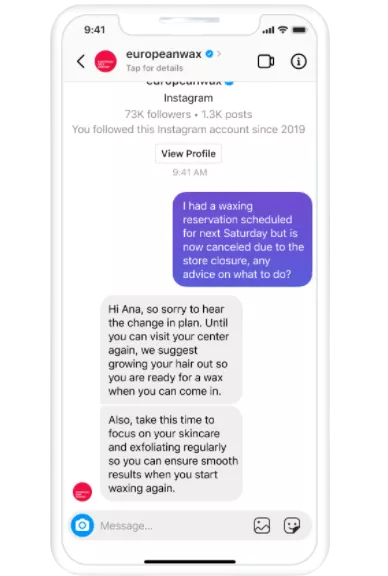
Using automated workflows that categorized, labeled, and prioritized requests, employees were able to respond very quickly to concerned customers, and also provide them with useful beauty tips!
6. Customer journey: build loyalty via messaging
The last stages of the customer journey are all about building loyalty to the customer. If customers trust a brand, they are more likely to become repeat customers. Messaging can help in two ways: offering guidance during the shopping process and inspiration after the sale.
a) Guiding customers during the shopping process
T1TAN is a company that specializes in goalkeeper gloves. The start-up manages most of its customer communication already exclusively on messaging channels.
Accordingly, the T1TAN team answers any customer inquiries about orders, returns, but also about the everyday life of a goalkeeper – how do I care for my gloves, how can I become an even better goalkeeper – via WhatsApp. This allows T1TAN to better guide their customers during the shopping process, and deliver a highly personalized experience.
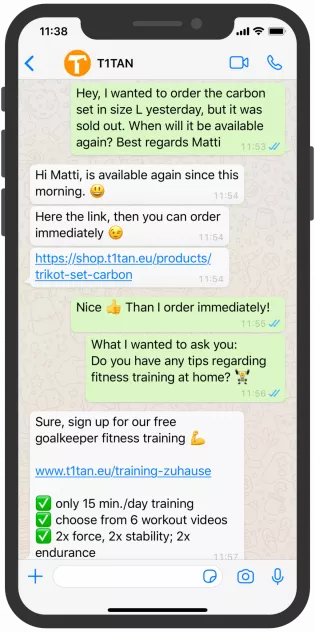
This conversational approach helps T1TAN build a very close relationship with their customers, who, in turn, become loyal customers, and keep coming back for new products.
b) Inspiration after the sale
The Brazilian supermarket chain, AMPM, started a loyalty program on WhatsApp. Customers that buy certain products, like Ben & Jerry's ice cream, are eligible to enter a raffle. This is a clever idea to get existing customers re-engaged and incentivize sales.
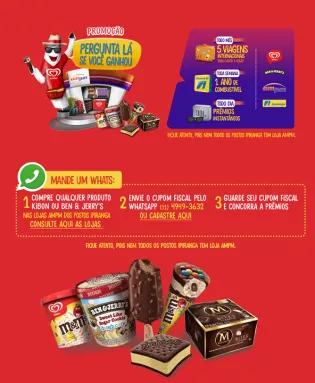
7. Recommendations
If a company delivered a positive customer experience throughout the customer journey, customers are more likely to recommend them to others. This type of "word of mouth" praise is the best marketing for any company, and therefore one of the most important key performance indicators for success.
Using messaging apps along the customer journey will get you more recommendations.
How to increase net promoter score with messaging
The German energy provider, E WIE EINFACH, offers WhatsApp as a customer service channel, and also to help existing customers speed up certain processes, such as sending their meter readings. And their customers love it!
With the highest net promoter (recommendation) score (NPS), WhatsApp is the most popular customer service channel, says Thomas Koch, Head of Online Service.
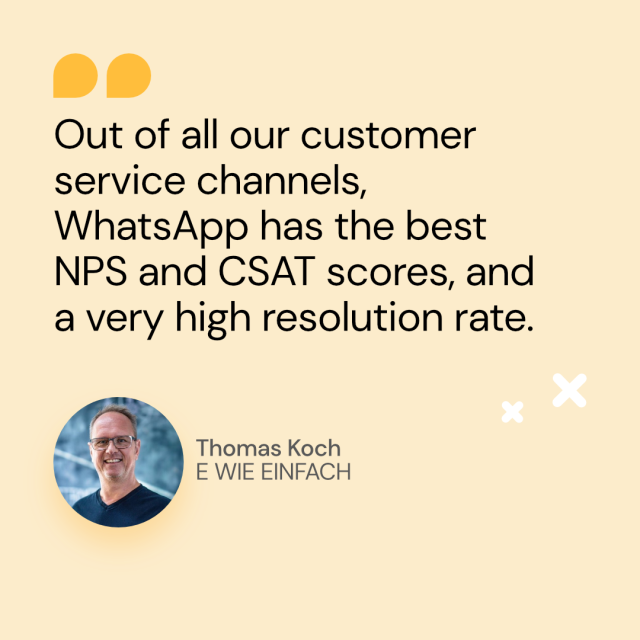
8. Get reviews
Next to recommendations, reviews on platforms such as Facebook, Google, or Yelp are priceless for companies. Positive reviews show that customers are happy with their service, and can make the difference in the purchase decision of a new customer.
Messaging apps can be a great tool to get more positive reviews from happy customers.
Use a messaging chatbot to get more positive reviews
Once you have started a chat with a customer on a messenger service like WhatsApp, it's really easy to stay in touch with your customers, and reach out again. For instance, after a completed purchase, you can ask for a review. By using a simple chatbot you can make sure that you'll get more positive reviews. ⭐⭐⭐⭐⭐
The sports brand Sportstech, for example, uses a WhatsApp chatbot to get more positive reviews.
- In a first step, the chatbot asks customers if they were happy with the service.
- If customers leave feedback of one to three stars, the bot offers them to talk to an agent to see how the service can be improved i the future.
- If customers leave four or five stars, the bot asks them to leave a review on Amazon or other online review platforms.
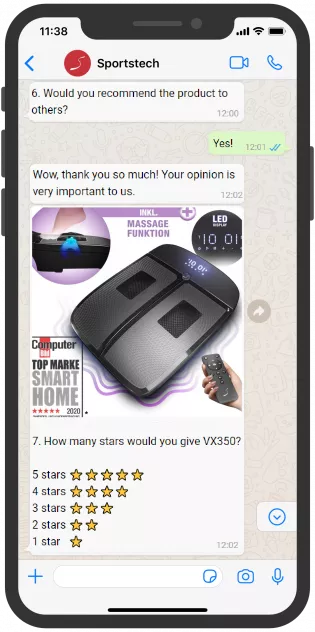
9. Retention
Messaging channels have one huge advantage over live chats or phones: once you have started a conversation with a customer, it's really easy to re-start it. Customers can just jump back into the chat, and say: "I would like to buy the same product again." No need to go through an entire online ordering process again, and companies save customer acquisition costs.
Moreover, with special newsletter tools for messaging apps, you can also reactivate customers by sending out highly personalized marketing campaigns to existing clients.
Using messaging newsletter to trigger repeat purchases
The Indian e-commerce initiative Tata CLiQ offers luxury brands, home, fashion, and beauty products at affordable prices. As a way to engage customers in post-sale conversations, they offered to send interested customers personalized recommendations on WhatsApp.
Based on the customers' browsing history, abandoned cart status, or wish list savings, Tata CLiQ then used WhatsApp marketing messages to re-engage customers.

The retention campaigns are a big success. Tata CLiQ attributed 500,000 US dollars in sales to WhatsApp, and they also noticed that customers were 1.7 times more likely to make a purchase when using WhatsApp.
Conclusion: Using messaging along the customer journey offers many advantages
Messenger apps are an effective tool for customer communication that you can use at any touchpoint in the customer journey. And: they are also more effective than e-mail, phone, or social media.
Conversational messaging lets you communicate with your customers in the same environment as friends and family. This increases trust, and makes the interaction more personal. In addition, customers prefer the flexible and comfortable communication that messaging channels offer. In the end, messaging apps allow you to be closer to your customers in every step of their customer journey.
There are also several benefits to this approach.
- Constant product improvement: customer feedback on messaging apps is more direct, more frequent, and tends to be more positive than, for instance, on social media. This, in turn, helps you to constantly improve your offer.
- Lower customer acquisition cost: You build a closer relationship to your customers, and it's easy (and cheap!) to re-start a conversation. This is a lot more effective than having to "buy" new customers with Google or Instagram ads.
- Higher net promoter score: Happy clients buy again and recommend.
💡Tool tip: Check out Sinch Engage, the first professional ticket system that is easy to use and offers 100 percent data protection. It'll enable you to use messaging throughout the entire customer journey. Use messaging apps like WhatsApp, Instagram Direct Messages, Apple Messages for Business, Facebook Messenger, Telegram, and Viber in one tool, and on a single centralized platform — no coding skills needed. Try Sinch Engage for free!

